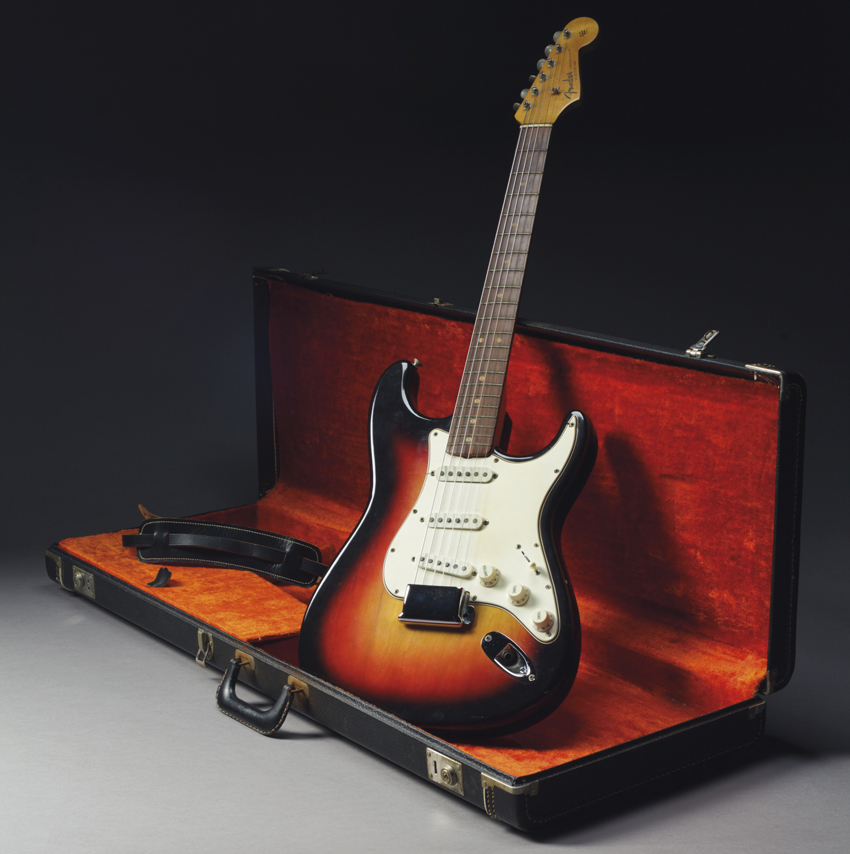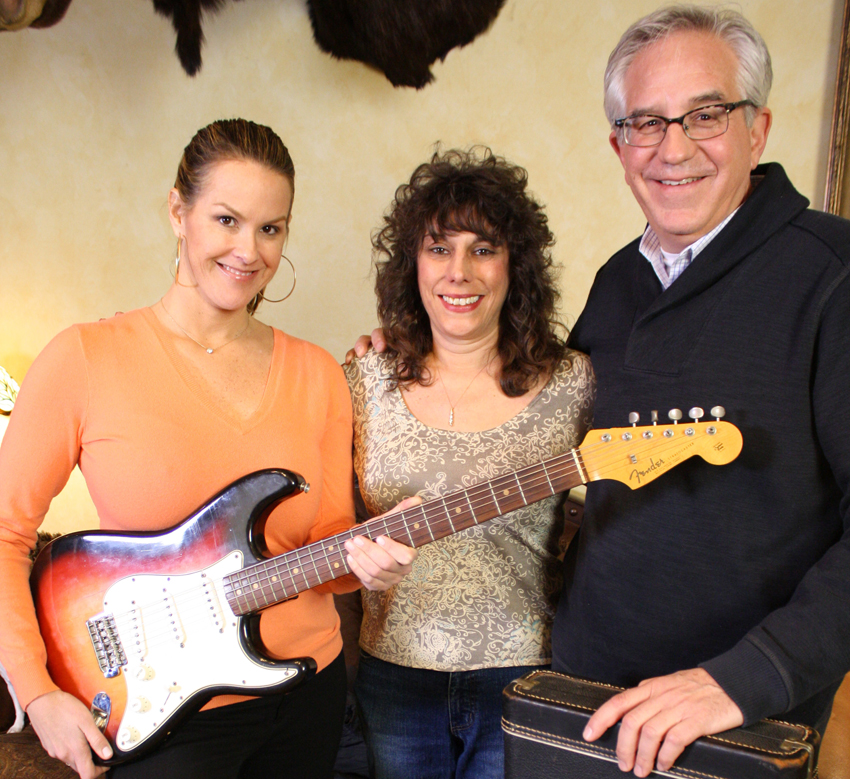Bob Dylan's Newport Strat sells for $965,000
Historic guitar breaks auction record

The historic '64 Fender Stratocaster used by Bob Dylan at the 1965 Newport Folk Festival has been sold for a record breaking sum at auction.
The sunburst Strat took centre stage at Christie's in Manhattan last Friday - and no wonder.
The alder body, maple neck and Brazilian rosewood fingerboard were all in decent nick, but it was the guitar's backstory that garnered all the attention.
Clearly, the unidentified bidder who eventually settled on a record-breaking $965,000 purchase, knew what they were getting their hands on.
Originally owned by Bob Dylan, the guitar used by the legendary, great American poet in his first-ever electric gig at the 1965 Newport Folk Festival in Rhode Island.
The three-song electric set in front of a crowd of 20,000 has gone down in music history as the moment Dylan stepped away from his folk roots towards an electrified future.
Blasting onto stage with Maggie's Farm, followed by Like a Rolling Stone and Phantom Engineer (which would eventually evolve into It Takes a lot to Laugh, It Takes a Train to Cry), Dylan's Newport appearance was a no-nonsense declaration of independence from the folk protest movement.
Want all the hottest music and gear news, reviews, deals, features and more, direct to your inbox? Sign up here.
Dressed in black sunglasses and leather jacket, Dylan's decision to go electric reinforced his singular artistic vision in spectacular, unforgettable style. His performance, backed by the Paul Butterfield Blues band, is undoubtedly one of the most written about performances in the history of rock 'n' roll.

The legendary Newport Stratocaster
Scene legend Bob Jones, who helped organize the Newport Folk Festival from its inception in 1959, will never forget it:
"It was a stunner for music back then for Bob Dylan to play like that," he said.
"The folk music community did feel betrayed. Here was a guy who was leaving them behind and moving on to another genre, he was deserting the political scene. It was nothing to do with the music or the electric element. He wasn't supposed to be doing that. He was supposed to be standing up there with an acoustic telling everybody how to vote.
Yet although Dylan's performance is often thought of as the moment a visionary wielding an electric guitar blew away an old-fashioned acoustic-oriented folk crowd, Jones points out that he wasn't the only guitarist plugging in that day.
"Yes it may have been out of sync from what the festival normally did in terms of what constituted folk music at the time but in truth, there were many acts that year who used electrics, " added Jones.
"Muddy Waters, the guys Johnny Cash played with, Swan Silvertones who were gospel singers - all those guys used electric guitars.
"Dylan though wasn't just singing songs of old traditions, he was such a big protest singer and at first the audience had some trouble understanding him.
"Some guitarists like to play with the sound distorted somewhat, that's part of the sound they want, the way it comes off the amp. Some of the sound people that day actually wanted to turn the volume on his guitar down and turn his vocals up. Joe Boyd was at the desk that day too.
"People have said there was a lot of booing, others were cheering but I know he didn't hang around long after. The irony was that a lot of the guys in his band had played an electric gig earlier in the day.
"Things started to change after '65. Certainly in terms of the festival, we were trying to get the likes of Buffalo Springfield, moving into the new rock n roll/folk scene. It moved towards the more electric side of music. By the time 1970 came along, there was straight out rock n roll - Led Zeppelin, Blood Sweat and Tears. Jimi in '67.
"They didn't even plan a folk festival for 1970, there was supposed to be one in '71 but there were problems and that was it.
"Music was evolving, it was similar to what had happened in jazz, big bands faded, people couldn't understand bebop. The folk scene was similar in many ways. That day was the catalyst for the change. These new guys were killing it, the public were going after them like ice cream sodas on a hot summer's day."
"It didn't change him at all. I just loved him for his lyrics. He could have played the harp for all I cared. Some people had difficulty understanding him. I wasn't surprised the guitar went for such a big sum although I never thought it would bring in almost a $1 million.
"After all, when you look at it, it looks just like any other. It was nothing special."
The previous record for a guitar at auction was for another illustrious Strat: Eric Clapton's legendary 'Blackie', which sold for $959,000 in 2004.
Amazingly, the Dylan Strat had spent 40 years in the loft of Dawn Peterson whose late father Vic Quinto, a New Jersey-based commercial pilot hired by Dylan's manager to fly his artists, had found it in the back of his plane and received no demands to hand it back.

Dawn Peterson with the History Detectives team and the iconic Strat (credit: Corbis)
Although there were initially questions raised by Dylan's management about the guitar, TV show History Detectives authenticated it in July 2012. The plan of selling was quickly mooted.
Photographer John Rudoff, whose rare colour pictures from the festival were used to help confirm the identity of the guitar, remembers the day of Dylan's performance well.
"I was backstage for most of that day, shooting artists," he recalls.
"I heard a few snippets of conversation that something was brewing. When he came out, it was astonishing. There a moment of pause and then he started the set. No pun intended - it really was electrifying.
"There was a lot of applause but you could hear some booing too. It's quite unmistakable."
"I was a traditionalist - I saw him first in August 1963, The rapidly evolving folk scene in New York City , Boston and to some extent in Philadelphia were very close to me. I was not an immediate convert, I was more interested in his traditional folk performances.
"But for me, he still remains up there with Pete Seeger and Woody Guthrie in terms of most influential writers of all time.
"In the early 50's post war there was a gradual demise of the big band sounds, Elvis and early rock n roll was also around but then the pop music, surf, Beach Boys sound were beginning to dominate in the late 50's. That occupied a pretty high position in public American pop music life. But then there was bifurcation of British and black influenced rock n roll and the American home-grown folk music.
"The fact that those two strains of music were so different is what caused the tension as a result of that concert. He was the first guy to have prominently and publicly gone from one strain to the other. It would be like Mick Jagger singing "Blowing in the Wind" on an acoustic. He didn't do that. But Bob did.
"Everything changed. It really was that big a deal. Within the next year or two, everyone was doing it. Before then, there really was no crossover between different genres.
"As a writer, speaker and soundboard of his generation, he was unparalleled. He never stopped the brilliance of his writing. "
Christie's in-house specialist Thomas Lecky, the man charged with auctioning the guitar, summed it all up quite beautifully.
"It was the moment Bob Dylan transformed his career from a folk troubadour to a visionary, surrealist poet and made music which transformed the way everyone made music," he said.
"There had been interest from all corners of the earth. It represented a seminal moment in music history. Everyone knows about how he was called Judas by fans in the UK after this, how they felt he had betrayed them. So it was such a bold, important moment in history.
"Everyone recognized this was a guitar which had mystical power. "